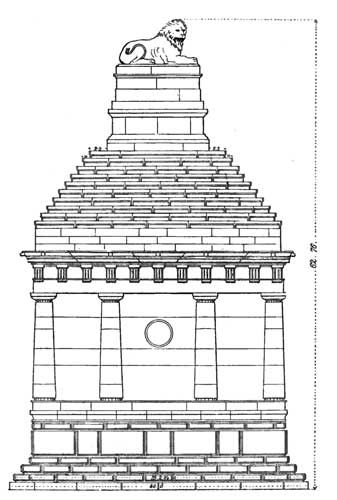.
As you go up from the Peiraeus you see the ruins of the walls which Conon restored after the naval battle off Cnidus. For those built by Themistocles after the retreat of the Persians were destroyed during the rule of those named the Thirty. Pausanias
| Battle of Cnidus | |||||||||||
|---|---|---|---|---|---|---|---|---|---|---|---|
| Part of Corinthian War | |||||||||||
|
|||||||||||
| Combatants | |||||||||||
| Persia | Sparta | ||||||||||
| Commanders | |||||||||||
| Conon and Pharnabazus | Peisander | ||||||||||
| Strength | |||||||||||
| 90 triremes | 85 triremes | ||||||||||
| Casualties | |||||||||||
| Minimal | Entire fleet | ||||||||||
|
Greek Wars of the 4th century BC
|
|||||||||||
At the Battle of Cnidus (394 BC), the Persian fleet, led by the former Athenian admiral Conon, utterly destroyed the Spartan fleet led by the inexperienced Peisander, ending Sparta's brief bid for naval supremacy.
The battle was a significant boost for the anti-Spartan coalition that resisted Spartan hegemony in the course of the Corinthian War.
Prelude
In 394 BC, King Agesilaus II of Sparta and his army were recalled from Ionia to the Greek mainland to help fight the Corinthian War. The Spartan fleet, under Peisander, also began to return to Greece, sailing out from its harbor at Cnidus.
Meanwhile, the Persian fleet, under the joint command of Conon and the Persian satrap Pharnabazus sailed out from the Chersonese to oppose the Spartans. The fleets met near Cnidus.
The Battle
Sources are vague for the events of the battle itself. It appears that the Spartan fleet encountered advance elements of the Persian fleet and engaged them with some success. Then the main body of the Persian fleet arrived and put the Spartans to flight, forcing them to beach many of their ships. The Spartans lost their entire fleet, with heavy casualties; 50 Spartan triremes were captured by the Persians. Peisander was killed while fighting to defend his ship.
Aftermath
This battle ended the Spartans' attempt to establish a naval empire. Sparta never again engaged in major military efforts at sea, and within a few years Athens had reclaimed her place as the preeminent Greek sea power.
Following his victory, Conon took his fleet to Athens, where he supervised the rebuilding of the long walls, which had been destroyed at the end of the Peloponnesian War.
With Sparta removed from the scene, Persia reestablished its dominance over Ionia and parts of the Aegean. The Peace of Antalcidas in 387 BC officially ceded control of these areas to Persia; it would continue to hold them until the arrival of Alexander the Great half a century later.

Conon's Lion Tomb in Cnidus for the 394 BC victory
References
- Xenophon, Hellenica
- Diodorus Siculus, Bibliotheca Historia
Links
The relevant passage from Xenophon.
The relevant passage from Diodorus Siculus.
| Ancient Greece
Science, Technology , Medicine , Warfare, , Biographies , Life , Cities/Places/Maps , Arts , Literature , Philosophy ,Olympics, Mythology , History , Images Medieval Greece / Byzantine Empire Science, Technology, Arts, , Warfare , Literature, Biographies, Icons, History Modern Greece Cities, Islands, Regions, Fauna/Flora ,Biographies , History , Warfare, Science/Technology, Literature, Music , Arts , Film/Actors , Sport , Fashion --- |
Retrieved from "http://en.wikipedia.org"
All text is available under the terms of the GNU Free Documentation License

